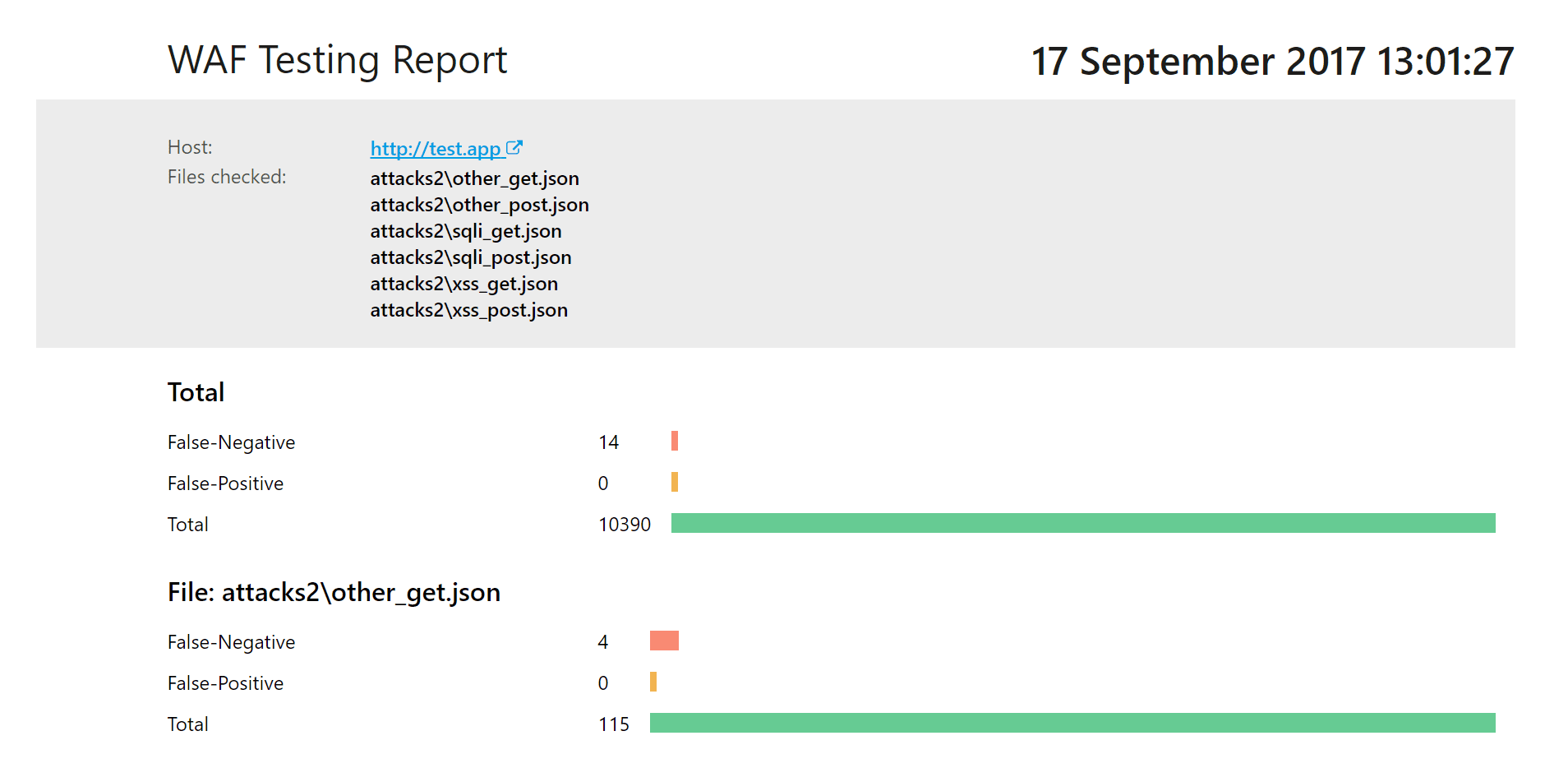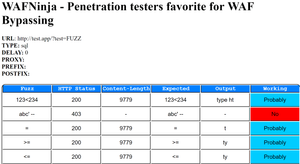A while ago I had to make comparison of different Web Application Firewalls based on their security level protection. And as result made WAF Testing Tool (wtt). It is python cli script that sends various attacks to protected application and checks if request is blocked or hits application.
Its work is simple:
- parse JSON-files with attack patterns
- form HTTP requests
- sends requests to application
I have gathered attack samples from different sources like github repositories of different testing tools or articles describing WAF bypass techniques. For now there are 270 SQL Injections, 4810 Cross-Site Scriptings and 115 rest of payloads like Local File Inclusions, Shellshock, XML External Entities etc.
Features
- Basic, Form-based or Cookie authentication
- Block action detection by HTTP status codes, page content pattern (string, regex)
- CSRF-tokens that could be parsed from page content and added to POST-requests
- Health-check to detect if client was blocked by IP
- Multi-threading
- Nice looking HTML-reports
Also it uses keep-alive connections, which adds performance on applications with SSL, since there is no need to establish new HTTPS connection for each request.
Deployment
You need to install python with its dependencies: jinja2 to generate reports and optionally tqdm for nice looking progressbar.
For tests I used ModSecurity with full set of OWASP Core Rules Set 3.0 with Paranoia Level (PL) 1.

Tests
Usage examples
# python wtt.py --help
usage: wtt.py [-h] -f PATH -u URL [-a UA] [-c COOKIE] [-o OUTPUT]
[-t {status_code,pattern,regex}] [-p PATTERN] [--all]
[--auth {basic,digest,http}] [--auth-url AUTH_URL]
[--auth-params AUTH_PARAMS] [--csrf] [--csrf-name CSRF_NAME]
[--csrf-sendname CSRF_SENDNAME] [--health HEALTH]
[--report-template REPORT_TEMPLATE] [--threads THREADS]
Waf Testing Tool
optional arguments:
-h, --help show this help message and exit
-f PATH, --folder PATH
Path to folder containing attacks samples
-u URL, --url URL Set WAF address, e.g.http://127.0.0.1/
-a UA, --useragent UA
Set User-Agent header value
--referer Set Referer header value with request hostname
-c COOKIE, --cookie COOKIE
Set Cookies informat key1=value1,key2=value2
-o OUTPUT, --output OUTPUT
Output file (default: report.html)
-t {status_code,pattern,regex}, --type {status_code,pattern,regex}
Detect blocked page based on HTTP response
code,pattern or regular expression (default:
status_code)
--codes CODES List of status codes for blocked pages
e.g. 403 or 403,500
-p PATTERN, --pattern PATTERN
Detect blocked page based on status code or pattern
--all Include passed attack to report
--auth {basic,digest,http}
Enable authentication
--auth-url AUTH_URL Set url for authentication
--auth-params AUTH_PARAMS
Set authentication parameters in format
key1=value1,key2=value2. E.g. for basic and digest
auth username should be set as login, password as
password: login=john,password=pwd123
--auth-success AUTH_SUCCESS
Regex pattern to find in response and detect if HTTP
auth was successful.
--csrf Get CSRF-token from response (body, header or cookie)
--csrf-name CSRF_NAME
Param name, that should be found in response
--csrf-sendname CSRF_SENDNAME
Set param name, that is placed in POST-requests if it
deffers with csrf-name
--health HEALTH Check server availability frequency (default: 10,
disable: 0)
--report-template REPORT_TEMPLATE
Set jinja2 report template
--threads THREADS Set threads number (default: 1)
Launch string sample
python wtt.py -u http://protected.app.local/ -f owasp --auth http --auth-params login=bee,password=bug,security_level=0,form=submit --auth-url http://172.16.9.34/bWAPP/login.php --auth-success Welcome.Bee --csrf --csrf-name X-Csrf-Token --csrf-sendname csrftoken -o beebox_report.html --all --threads 5
Set blocked attacks criteria
python wtt.py -u http://protected.app.local/ -f owasp -t status_code 403,500
python wtt.py -u http://protected.app.local/ -f owasp -t pattern -p Forbidden
python wtt.py -u http://protected.app.local/ -f owasp -t regex -p ID:.*
Authentication by setting Cookie
python wtt.py -u http://protected.app.local/ -f owasp -c PHPSESSID=1234abcd5678efgh,some_value=1
Basic/Digest authentication
python wtt.py -u http://protected.app.local/ -f owasp --auth basic --auth-params login=John,password=123
python wtt.py -u http://protected.app.local/ -f owasp --auth digest --auth-params login=John,password=123
HTTP authentication
python wtt.py -u http://protected.app.local/ -f owasp --auth http --auth-url http://protected.app.local/bWAPP/login.php --auth-params login=John,password=123,form=Submit --auth-success Welcome.Bee
Get CSRF token for POST-requests
python wtt.py -u http://protected.app.local/ -f owasp --csrf --csrf-name csrftoken
Attack template example
As I said, attacks are stored in JSON-format
{
"body":"title=adsf'%20or%201%3D1%20--%201&action=search",
"description":"SQL Injection (POST/Search)",
"url":"/bWAPP/sqli_1.php",
"status_code":403,
"block":true,
"id":"OWASP_A1_27",
"headers":{
"Connection":"keep-alive",
"Content-Type":"application/x-www-form-urlencoded",
"User-Agent":"Mozilla/5.0 Windows NT 6.3; Win64; x64 AppleWebKit/537.36 KHTML, like Gecko Chrome/44.0.2403.107 Safari/537.36"
},
"method":"POST",
"payload":"adsf' or 1=1 -- 1"
}
Here you can specify:
body: request body, should be Null for GET requestsdescription: this field is added to report to understand what attack type was passedurl: additional url path to-uparameter in clistatus_code: expected status codeblock: says if attacks should be blocked or not (in case of false positives check)id: attack id, also added to report, and with this ID it'd be easier to find this attack in file with patternsheaders: additional headers likeUser-Agentmethod: request type (GET,POST,PUTetc.)payload: urldecoded string, that is added to report
If you have payload samples that should be used with this tool, you can convert them to JSON format with conversion script payload2attacks.py
python payload2attacks.py -i folder_with_payloads -o folder_for_ready_attacks -m get,post
python payload2attacks.py -i folder_with_payloads -o folder_for_ready_attacks -m all
It takes payload from file line by line and adds them to JSON-formatted file for attacks GET-, POST-request or/and Header.
ModSecurity testing results
I was checking only GET and POST requests, since apparently ModSecurity does not perform urldecode of headers and that's why doesn't detect lot of attacks there. Actually, headers are usually not urlencoded but that fits RFC5987, so it would depend on application how to work with headers and in theory may lead to vulnerability.
The script was launched with following parameters:
python wtt.py -f attacks2 -u http://test.app/login.php -t status_code --codes 403
With total of 10390 attacks only 14 were not blocked. There is a list of unique payloads that were met in GET and POST request
././.htaccess
C:/inetpub/wwwroot/global.asa
C:\inetpub\wwwroot\global.asa
%27+%0A%09%09%09%09%09%09};+%0A%09%09%09%09%09%09alert%280%29;+%0A%09%09%09%09%09%09a%20=%20{+%0A%09%09%09%09%09%09%09%27a%27+:+%27
'+alert('XSS')+'&st=1&[email protected]
'+alert(1)&&null=='
Resume
Even with up-to-date Core Rules Set 3.0, we have found couple of attacks that may bypass ModSecurity. In real life for user it is easier to disable some of the rules, than changing regex patterns to get rid of false positives. So, usually, this amount of valid payloads is higher. However, payloads work only with PL 1, and increasing it will reduce working attacks count, but will also increase false positives.
This WAF Testing Tool is a good way to make quick comparison of possible WAF solutions or check that security level was not decreased during protection mechanisms optimization.








